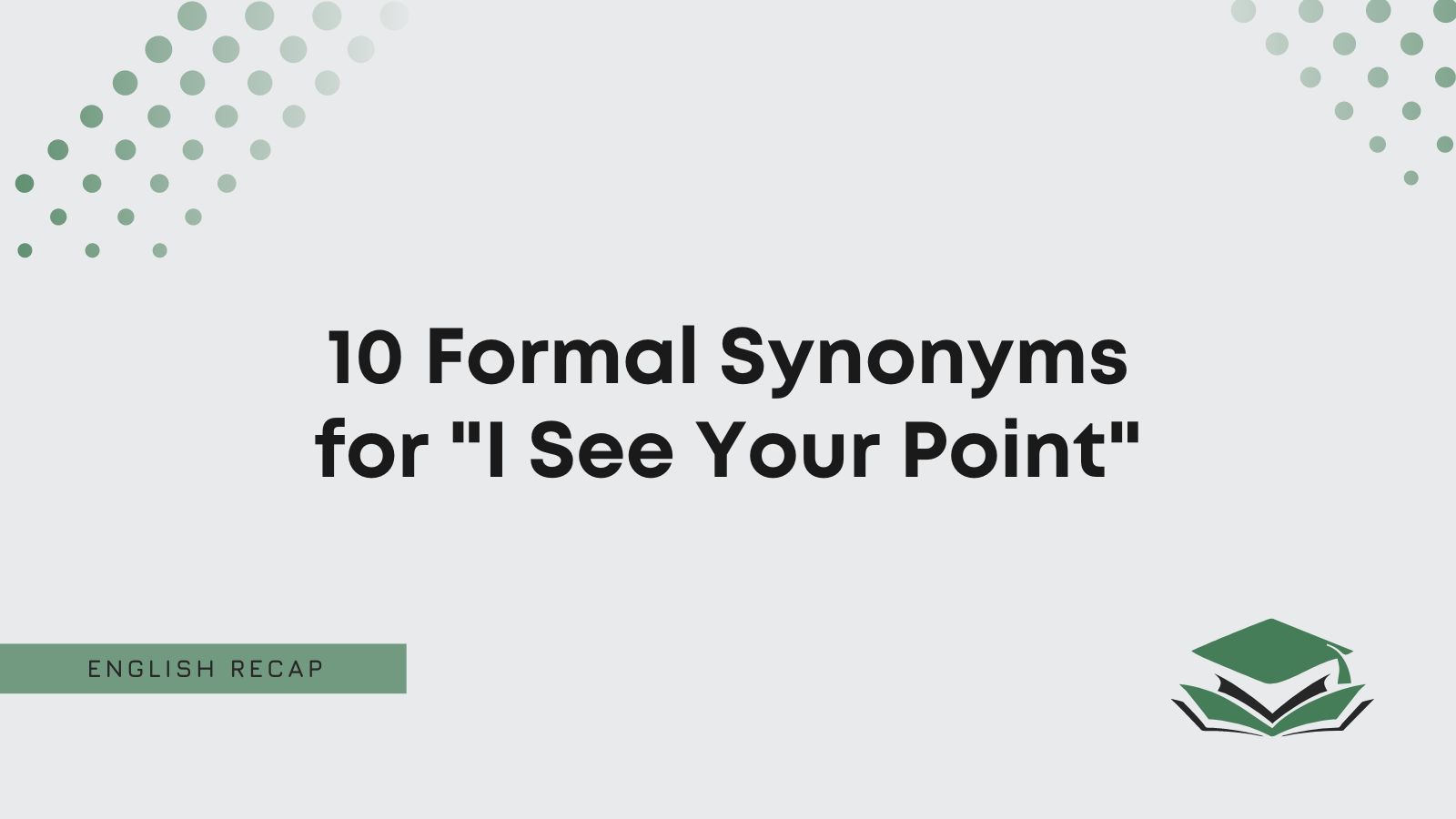So, you want to know how to say “I see your point” in an email.
Well, if you’re worried that “I see your point” is a bit informal or conversational, you’ve come to the right place.
This article will explore some formal alternatives to help you understand better choices that work in emails.
Is It Formal to Say “I See Your Point”?
It is not formal to say “I see your point.” The phrase isn’t designed for business emails, so it won’t work well if you try to include it when talking to professional people (like clients or employers).
However, just because it’s not formal doesn’t mean it’s rude. The phrase is not rude and shows that you understand what someone is saying.
It’s a great way to let someone know you see their point of view and want to do what you can to help them.
Here’s a great email sample to help you if you’re still confused:
Hi Max,
I see your point with this. I’ll see if there’s anything I can do on my end to make things a little easier.
Yours,
William Bradford
Pros
- It’s friendly and conversational.
- It’s got a personal touch to it that shows you care about someone’s perspective.
Cons
- It’s informal, so it doesn’t work in professional emails.
- It’s a bit generic.
“I see your point” certainly isn’t the best choice to include in formal writing. Therefore, you’ll need to explore some alternatives to help your emails sound more professional.
So, keep reading to learn how to say “I see your point” professionally. We’ve gathered some great synonyms to help you explore your options.
What to Say Instead of “I See Your Point”
- I understand your perspective
- I get what you’re trying to say
- Your argument makes sense
- I understand your point
- I acknowledge your standpoint
- Your point is well-reasoned
- Trust me; I understand you
- I recognize the logic in what you’re saying
- Your viewpoint is noted
- Your position is clear
1. I Understand Your Perspective
To start with, you can write “I understand your perspective” as a formal way to say “I see your point.”
It keeps things much more professional in your emails.
You can use it when emailing an employee. It suggests that you understand what they’re trying to say or see where they’re coming from.
If you can relate to your employees, you’re more likely to learn their thoughts. They’ll trust you more and confide in you, which could help you in the long run.
Here’s a great email sample to show you how it works:
Dear Adam,
I understand your perspective here. I’ll do what I can to help you, but I’m not sure when we’ll be able to work through this.
All the best,
Joana Clearly
2. I Get What You’re Trying to Say
You may use “I get what you’re trying to say” as another way to say “I see your point.”
It’s a useful phrase that works well in friendly situations. Don’t worry; it still works in emails, but it’s better when you know the recipient well.
For instance, you can use it when relating to a coworker. It shows that you understand them and want to show that you’re on their side.
Also, this example should help clear things up:
Dear Max,
I get what you’re trying to say. However, I don’t think we can stop them from going through with these changes.
All the best,
George Storm
3. Your Argument Makes Sense
Try using “your argument makes sense” when relating to a client. If they’re not happy with something, this could be a great way to show them that you support their feelings.
Generally, it lets people know you see their point and understand their logic.
Understanding and supporting someone’s point helps them to trust you. It’s a formal and respectful way to let someone know they’re on to something, and you’ll try to help.
Please refer to the example below to see how it works:
Dear Ms. Scott,
Your argument makes sense, and I’m doing all I can to help you. Please bear with me while I sort this out, though.
Yours,
Stacey Clough
4. I Understand Your Point
Feel free to include “I understand your point” instead of “I see your point.” Naturally, it only makes a slight change from the original phrase.
However, it’s a good formal synonym to include to help you mix things up in your emails.
We recommend using it when empathizing with a coworker. It’s a good way to let them know that you understand what they’re trying to say and share a similar point of view.
If you still need help, review the following example:
Dear Richard,
I understand your point, but I doubt they’re going to help you. You’ll have to wait a while before they’ll hear you out.
All the best,
Georgia Danvers
5. I Acknowledge Your Standpoint
Even if you don’t agree with someone’s point of view, it’s good to let them know that you see what they’re trying to say.
That’s where “I acknowledge your standpoint” comes in. It’s highly effective because it shows you appreciate someone’s view without believing it.
It keeps things respectful and genuine when you’re sending your emails.
Try it when emailing a client to show that you’re doing what you can to help them. Even if you don’t agree with what they’ve said, this is a good way to keep them in the loop.
We also recommend reviewing this email sample:
Dear Miss Strong,
I acknowledge your standpoint here. Rest assured, I’ll do everything I can to assist you moving forward.
My best,
Joe Christiansen
6. Your Point Is Well-Reasoned
“Your point is well-reasoned” is a great way to highlight how clear someone’s position or point of view is.
The more well-reasoned a point, the easier it is to understand.
So, you can suggest that your boss’s reasoning is sound with this phrase. It keeps things professional and direct when letting them know that you understand what they’re saying.
Here’s a great sample email to show you more about how it works:
Dear Mr. Savage,
I believe your point is well-reasoned, and I’ll run it by my employers. Please let me know if you have anything else to share.
All the best,
Sean Michaels
7. Trust Me; I Understand You
Starting any phrase with “trust me” helps to show that you’ve got someone’s back. It’s empathetic and caring, which helps the recipient to see a more positive side of you.
We recommend using it when emailing a coworker. It shows you understand them and want to help however you can.
If they’ve come to you with a problem, this is a great way to show that you want to take their side.
It also helps that it’s friendly and respectful.
If you’re still unsure, you can refer to this example:
Dear Stacey,
Trust me; I understand you. I’ve understood you for a while, and I think we can use this.
Thanks so much,
Craig Hall-Card
8. I Recognize the Logic in What You’re Saying
Feel free to write “I recognize the logic in what you’re saying” instead of saying “I see your point.”
It keeps things quite respectful and professional when showing that you appreciate someone’s point of view.
This works quite well when emailing a client. It shows that you see where they’re coming from, even if you might not share the same perspective as them.
We also recommend checking out this example:
Dear Mr. Norwich,
I recognize the logic in what you’re saying. However, there are some things I can’t change about the situation.
Yours sincerely,
Sam Kwant
9. Your Viewpoint Is Noted
We also recommend using “your viewpoint is noted” when emailing a client.
It lets clients know you understand what they’re trying to say and where they’re coming from. This is a great way to show that you empathize with their perspective.
We highly encourage it if you’re trying to keep a civil and professional relationship with the recipient. It’s a great way to let them know you’re on their side and willing to hear them out.
Perhaps this email example will also help you with it:
Dear Mrs. Brett,
Your viewpoint is noted, and I’ll be sure to keep you in the loop. Please leave it with me for now, though.
All the best,
Jessica Young
10. Your Position Is Clear
When you understand someone’s point, it means you understand their position too. Therefore, “your position is clear” is a great formal synonym.
It’s a direct (maybe even blunt) way to let someone know you understand them.
It tells them they no longer need to explain themselves as you fully understand what they’re trying to say.
It works best when emailing a disgruntled employee. Use it when you’ve understood their point, even if you don’t necessarily agree with it.
You should also review this email sample:
Dear Marcus,
Your position is clear. I’ll see if there’s anything I can do to make things easier for you before we move forward.
Best regards,
Dan Wallace

